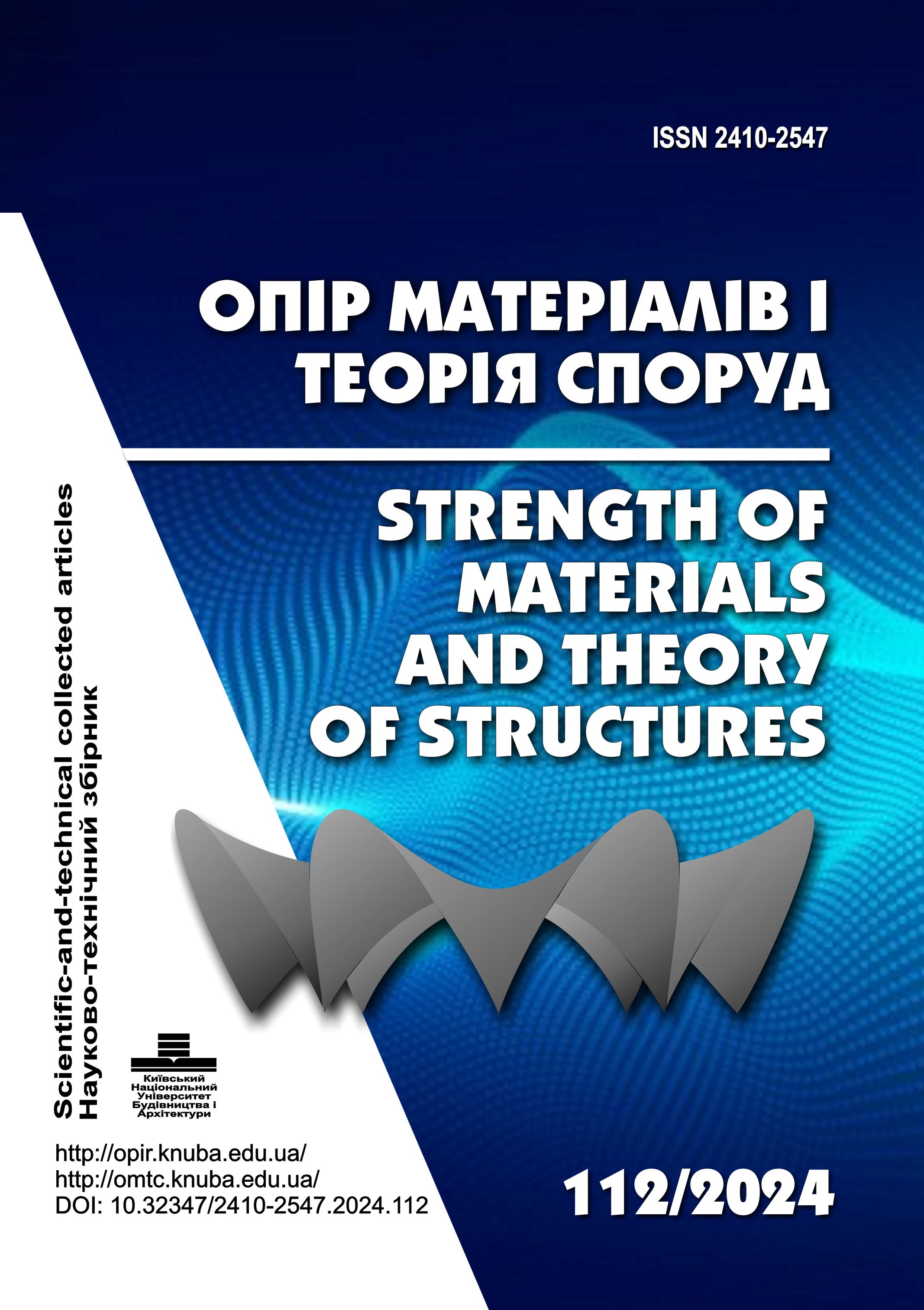Analysis of thermo-mechanical incompatibility of fullerenes with polymer matrices of composites
DOI:
https://doi.org/10.32347/2410-2547.2024.112.139-148Keywords:
polymeric composites, fullerenes, shell model, modified parameters, thermomechanical incompatibilityAbstract
Unique strength and rigidity properties of carbon nanotubes and fullerenes do them very perspective reinforcing admixtures into composites produced on the basis of polymeric and metallic matrices. It is established that even relatively small their dopes into composites can essentially enlarge physico-mechanical characteristics of polymers. At the same time, comparatively low value of the linear thermal expansion coefficient of carbon nanomolecules results in the possibility of the emergence of the internal mechanism of the additional intrastructural stresses origination in the polymer conditioned due to thermomechanical incompatibility of the composite fractions. To examine this possibility, the theoretical modelling of the thermomechanical deforming of the considered heterogeneous structures under thermal change action was carried out. In doing so, the fullerenes were simulated as a thin elastic shell with adduced (effective) thickness, elasticity modulus, Poissonn’s coefficient and linear thermal expansion coefficient, the polymer matrix was supposed to be a homogeneous elastic medium with the prescribed parameters of thermoelasticity. The system of constitutive ordinary differential equations was deduced, which described the thermoelastic stress-strainedstate of the elastic fragment chosen for consideration. These equations solutions were deduced in the closed form for the case when the system temperature changed in. Fenolformaldegid, epoxy rezin, polycarbonate, polyamide, polystirol, polyester, and polypropylene, possessing increased values of the linear thermal expansion coefficients, were chosen as the matrix materials. With these initial data, the values of the fullerene radial displacements were calculated for two magnitudes of the sphere radius. It is demonstrated that owing to the high value of the fullerene effective elasticity modulus, the thermal deflections of its wall poorly depend on the properties of the encompassing matrix and practically are equal to its free thermal displacements. The thermal stresses of the polymer matrices have the largest values in the zones of the interface surfaces and they decrease proportionally to cube of the radial coordinate, so, the damages provoked by them have localized character.
References
Gulyayev V. I., Mozgoviy V.V., Shlyun N.V., Zaets Yu. A., Bilobrytska O.I., Shevchuk L.V. Vnutrishnostrukturni termonapruzhennia v kompozytnykh materialakh z termomekhanichno nesumisnymy parametramy yikh fraktsii. (Intrastructural thermal stresses in composite materials with thermomechanically incompatible parameters of their fractions.). Lira-K, 2023, 302 pp.
Kovalenko A.D. Osnovy termoupruhosty (Basics of Thermoelasticity). Kyiv: Naukova Dumka, 1970. 239 p.
Ahmad S. Continuum elastic model of fullerenes and the sphericity of the carbon onion shells, The Journal of Chemical Physics, 2002, 116(8), 3396–3400. https://doi.org/10.1063/1.1446428
Esmaeal Ghavanloo, Hashem Rafii-Tabar, Ayesha Kausar, Georgios I. Giannopoulos, S. Ahmad Fazelzadeh. Experimental and computational physics of fullerenes and their nanocomposites: Synthesis, thermo-mechanical characteristics and nanomedicine applications, Physics Reports, 2023, V. 996, P.1-116. https://doi.org/10.1016/j.physrep.2022.10.003.
Ghavanloo E., Rafii-Tabar H., Fazelzadeh S.A. New insights on nonlocal spherical shell model and its application to free vibration of spherical fullerene molecules. Int J Mech Sci, 2019, 161–162:105046. https://doi.org/10.1016/j.ijmecsci.2019.105046
Ghavanloo, E., Izadi, R. & Nayebi, A. Computational modeling of the effective Young’s modulus values of fullerene molecules: a combined molecular dynamics simulation and continuum shell model. J Mol Model, 2018, 24, 71. https://doi.org/10.1007/s00894-018-3623-x
Harada S., Kozako M., Hikita M., Igarashi T. and Kaji H. Preparation of fullerene/epoxy resin composite with fine dispersion and its breakdown strength, International Symposium on Electrical Insulating Materials (ISEIM), Toyohashi, Japan, 2017, pp. 654-656, doi: 10.23919/ISEIM.2017.8166575.
Huang, N., Chen, Y., Xie, Y., Yang, W., Li, J., & Guo, H. Stiffening of double-shelled fullerene molecules under uniaxial strains. Fullerenes, Nanotubes and Carbon Nanostructures, 2024, 1–7. https://doi.org/10.1080/1536383X.2024.2329740
Jamal-Omidi M., Shayanmehr M., Rafiee R. A study on equivalent spherical structure of buckyball-C60 based on continuum shell model, Lat. Am. J. Solids Struct., 2016, V. 13, no. 5, pp. 1016–1029. https://doi.org/10.1590/1679-78252508
Kausar, A. Fullerene Reinforced Polymeric Nanocomposites for Energy Storage – Status and Prognoses. Front. Mater. 2022, 9, 150. https://doi.org/10.3389/fmats.2022.874169
Lixing Dai, Jun Sun. Mechanical properties of carbon nanotubes-polymer composites. In: Beber MR, Hafez IH, editors. Carbon nanotubes - Current progress of their polymer composites. IntechOpen, 2016, p. 1-41. https://doi.org/10.5772/62635
Shahriar Dastjerdi, Bekir Akgöz. On the statics of fullerene structures. International Journal of Engineering Science, 2019 142, P. 125-144. https://doi.org/10.1016/j.ijengsci.2019.06.002
Downloads
Published
Issue
Section
License

This work is licensed under a Creative Commons Attribution 4.0 International License.
Authors retain copyright and grant the journal right of first publication with the work simultaneously licensed under a Creative Commons Attribution License that allows others to share the work with an acknowledgement of the work's authorship and initial publication in this journal.

